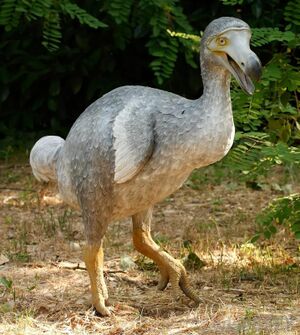Giswi: Difference between revisions
mNo edit summary Tag: 2017 source edit |
mNo edit summary Tag: 2017 source edit |
||
| Line 2: | Line 2: | ||
[[File:Dodo.jpg|thumb|right|Giswi in the wild]] | [[File:Dodo.jpg|thumb|right|Giswi in the wild]] | ||
===Habitat and Diet=== | ===Habitat and Diet=== | ||
Giswi in the wild have lived in the wooded areas in the lowlands near Corumm's eastern and southern coasts for thousands of years. Giswi in captivity can live up to 15 years if kept in sufficient numbers, solitary Giswi tend to have a much reduced lifespan due to their gregarious nature. Giswi are omnivorous birds and with their powerful beak and its high force load can eat anything from seeds, fruits, insects, fish, crustaceans and even smaller birds or mammals they may be able to catch. Giswi are noted for having a strong sense of smell. | Giswi in the wild have lived in the wooded areas in the lowlands near Corumm's eastern and southern coasts for thousands of years. Giswi in captivity can live up to 15 years if kept in sufficient numbers, solitary Giswi tend to have a much reduced lifespan due to their gregarious nature. Giswi are omnivorous birds and with their powerful beak and its high force load can eat anything from seeds, fruits, insects, fish, crustaceans and even smaller birds or mammals they may be able to catch. Giswi are noted for having a strong sense of smell. In modern farms Giswi are usually fed the standard chicken feed as other poultry. | ||
===Breeding and genetic engineering=== | ===Breeding and genetic engineering=== | ||
The domestic population of Giswi in its current form has been the subject of genetic modification such that they tend to be 15% larger on average than its wild counterparts and can grow significantly fatter. The eggs also tend to be larger, necessitating gradual modifications to the Giswi's buttocks tending towards the enlargement of the rear vent, that the oversized eggs may pass through. Despite this, 1 out of every 10 Giswi die due to egg laying complications. | |||
Revision as of 04:39, 21 February 2021
The Giswi (Giswinus Domesticus) also known as the Corummese chicken is a domesticated flightless bird native to Corumm. With an estimated population of 20 billion it is the most breeded type of poultry in Corumm above even the common chicken. Of this population, only a small minority still lives in the wild. It is raised in mega factories for its famously tough meat and prodigiously large eggs.

Habitat and Diet
Giswi in the wild have lived in the wooded areas in the lowlands near Corumm's eastern and southern coasts for thousands of years. Giswi in captivity can live up to 15 years if kept in sufficient numbers, solitary Giswi tend to have a much reduced lifespan due to their gregarious nature. Giswi are omnivorous birds and with their powerful beak and its high force load can eat anything from seeds, fruits, insects, fish, crustaceans and even smaller birds or mammals they may be able to catch. Giswi are noted for having a strong sense of smell. In modern farms Giswi are usually fed the standard chicken feed as other poultry.
Breeding and genetic engineering
The domestic population of Giswi in its current form has been the subject of genetic modification such that they tend to be 15% larger on average than its wild counterparts and can grow significantly fatter. The eggs also tend to be larger, necessitating gradual modifications to the Giswi's buttocks tending towards the enlargement of the rear vent, that the oversized eggs may pass through. Despite this, 1 out of every 10 Giswi die due to egg laying complications.